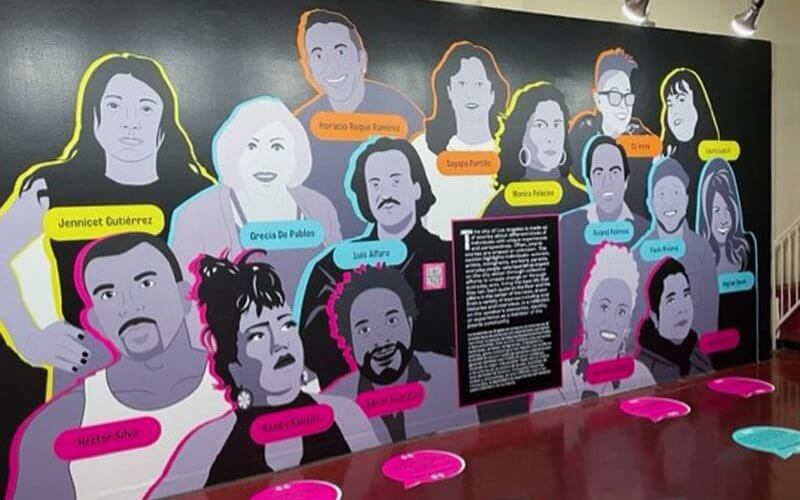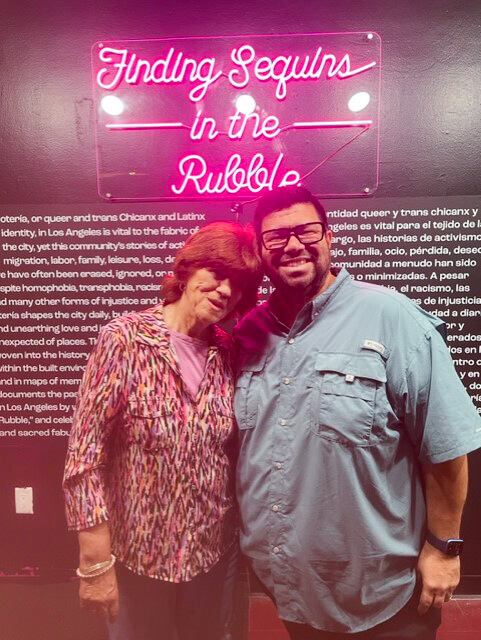
Curating a queer Latinx history exhibition for the first time at the Museum of Social Justice in downtown Los Angeles, Eddy Francisco Alvarez Jr. and his students were elated.
The jotería history exhibition is titled “Finding Sequins in the Rubble: Archives of Jotería Memories in Los Angeles.” Jotería is a reclamation of the slur “joto” and ”jota,” which previously was used to demean queer, Latinx community members but now is used to describe queer, Latinx people and their ways of thinking, living and creating, explained Alvarez, associate professor of Chicana and Chicano studies.
The “sequins” illustrate joyous celebrations in Latinx communities, from a first queer kiss to the euphoria of performing in drag. The “rubble” is a metaphor for such concepts as colonial violence, trauma, racial injustice and the imposition of binary gender systems.
Tracing back to the 1969 Stonewall Riot in New York City as the spark of the gay liberation movement in the United States, Alvarez and his students reimagined 34 safe havens in the past and present for queer, Latinx individuals in Los Angeles. In the exhibition, they mapped them as sequins that depict jotería histories.
The exhibition’s wall of activists commemorates 32 activists, artists, immigrants, workers and parents who have left an imprint in Los Angeles’s jotería community by championing transgender and undocumented rights in photography, education, playwright, filmmaking, fashion and erotic cholo artwork.

“I wanted to share these stories beyond writing an academic paper or a conference presentation. The exhibit is a way to educate and disseminate knowledge through public spaces,” said Alvarez. “I am inspired by my queer, Latinx or jotería mentors and ancestors who have laid the foundation for us to keep doing the work.”
Student Researchers Examine Queer Latinx Histories
Alvarez collaborated with students from his History of the Chicano course, which delves into evolving Chicano cultural identity and achievements dating back to the pre-Columbian period.
Students gained hands-on experiences, conducting oral history interviews, transcribing, creating maps and timelines, forming biographies and engaging in background research.
Erika Hernandez dreams of becoming a museum curator. Conducting oral histories for Alvarez’s exhibition was too good of an opportunity to pass up.
“Not only did I learn about how marginalized communities create spaces for self-expression, but also about their empowering activism and how to be an ally,” said Hernandez, an anthropology major with a concentration in Chicana and Chicano studies.
Curating an exhibit solidified Hernandez’s passion for advocacy in marginalized communities. On campus, she continues to explore the power of storytelling as a student assistant in the Lawrence de Graaf Center for Oral and Public History, which trains students to engage in historic preservation initiatives, curate museum exhibitions and collaborate in history, public art and culture projects.
Pursuing her degree in history with a concentration in Chicana and Chicano studies, Amalia Contreras sifted through oral histories learning about transgender and femme Latinx figures and documenting landmark locations where Latinx individuals explored their sexuality and met their first partner.
“I interviewed Maria, who accepted her sexuality after divorcing her husband and having four kids. She grew up Mormon and started dating her first girlfriend in her 30s,” said Contreras.
History student Erick Ortega immersed himself in the archives. He created and sorted documents, photographs and other media to form a timeline that illustrates the evolution of queer Latinx struggles and triumphs. His last contribution was writing biographies for the wall of activists that spotlights allies and historical figures that revolutionized the queer movement.
“This project allowed me to apply the skills I have acquired during my time at CSUF’s history department into other disciplinary fields,” said Ortega. “It was my first time working with an archive, and it was a good stepping stone in the direction I would like to achieve.”
Through students’ hands-on research methods, they were able to examine cultural hubs that embraced the jotería community. Two popular locations were El Conquistador and Le Barcito. The Condor replaced El Conquistador and became a hotspot for Los Angeles’ Queer Posada organization, which calls for resistance to gentrification in the neighborhood. Le Barcito displayed drag shows even featuring Selena Quintanilla, the “Queen of Tejano music.”
“When it comes to Chicano studies, Alvarez was one of the first professors to introduce jotería studies as its own branch within Chicano studies,” said Contreras. “I want to acknowledge his activism and hard work that he has done for the Latinx community on our campus.”